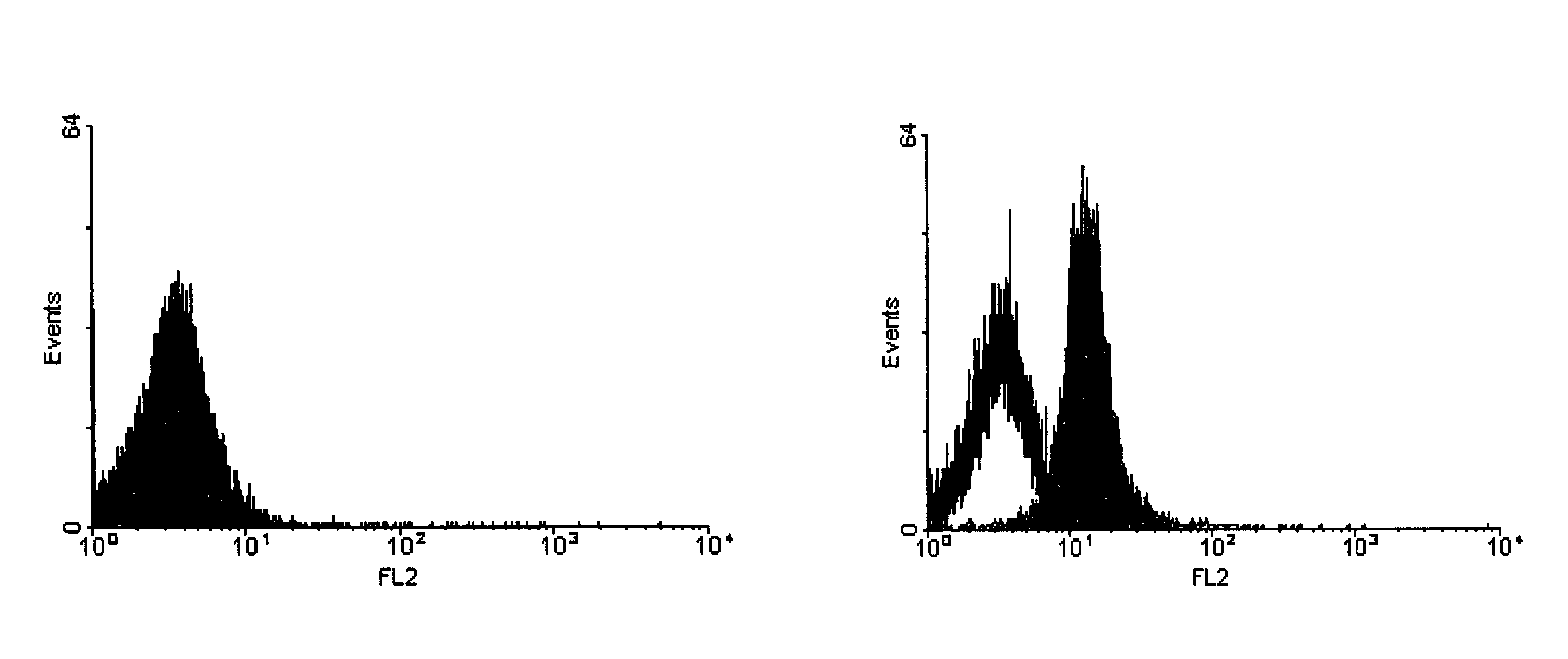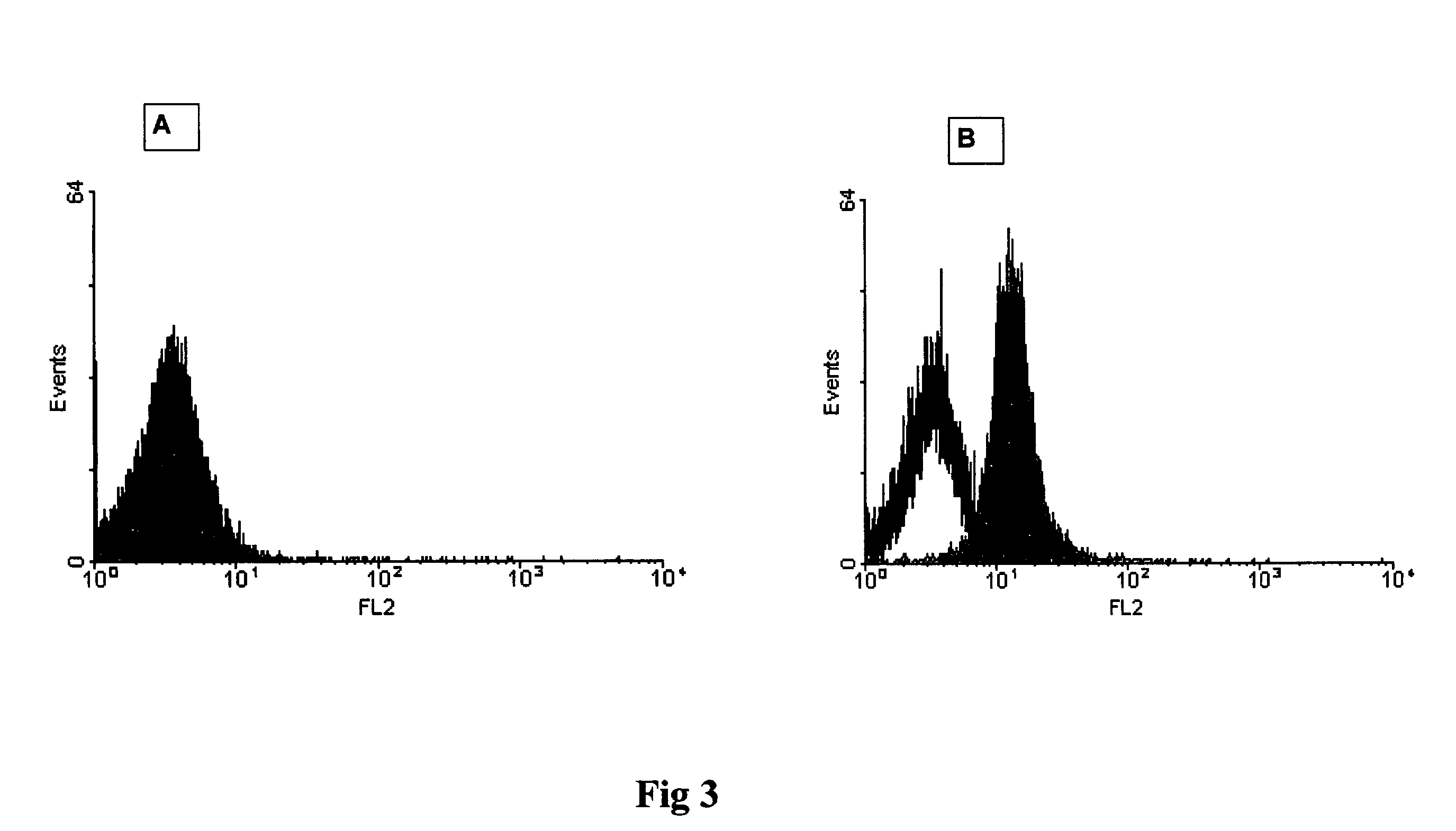Method for the Detection of Disease-Related Prion
a prion and disease technology, applied in the field of prion diseases, can solve the problems of a pre-treatment with proteases, a strong limitation of diagnostic capabilities, and a lack of protease sensitive prpsup>sc/sup>,
- Summary
- Abstract
- Description
- Claims
- Application Information
AI Technical Summary
Benefits of technology
Problems solved by technology
Method used
Image
Examples
example 1
[0044]The graph in FIG. 1 shows the results of a first experiment. The data shown illustrate that BSE positive plasma samples can be distinguished from negative samples using the sandwich immunoassay. The mean of double measurements are shown, whereas the error bars indicate the difference to the higher value.
[0045]96-well plates were coated with 2 μg / ml anti-IgM antibody diluted in phosphate buffered saline (PBS) pH 7.4, 0.1% bovine serum albumin (BSA) for 1 hour at room temperature. Unbound antibody was removed by washing the plates three times with PBS pH 7.4 containing 0.05% Tween-20. Thereafter, the plates were blocked for 2 hours and washed three times with PBS pH 7.4 containing 0.05% Tween-20. Conformation specific antibody 15B3 in PBS pH 7.4 at a concentration of 2 μg / ml was bound to anti-IgM for 1 hour at room temperature. After washing the plate three times with PBS pH 7.4 containing 0.05% Tween 20, 110 μl Plasma from BSE negative and positive cattle diluted 1:1 with Tris ...
example 2
[0046]The graph in FIG. 2 shows the results of a second experiment. The data shown illustrate that Sheep scrapie positive plasma samples can be distinguished from negative samples using the sandwich immunoassay. The mean of double measurements are shown whereas the error bars indicate the difference to the higher value.
[0047]Coating of plate with 15B3 antibody was performed as described in example 1. 110 μl of Plasma from scrapie negative and positive sheep diluted 1:1 with TBS containing 0.2% Sarcosyl was added to the plate and incubated for 1.5 hours at room temperature. Unbound proteins were washed away with TBS containing 0.1% Sarcosyl. POD labelled monoclonal antibody 805 recognizing amino acids 25-40 of PrP was diluted to 10 ng / ml in a buffer containing PBS pH 7.4, 0.02% Casein, 0.1% Tween-20 and added for 1 hour to wells. Unbound antibody was removed by washing for three times with PBS pH 7.4 containing 0.05% Tween-20. 100 μl of chemiluminescent substrate solution was added t...
example 3
[0048]The graph in FIG. 3 shows the results of a third experiment. The data shown illustrate that scrapie positive brain homogenate can be distinguished from negative samples using FACS analysis. A histogram is shown whereas y-axis indicates the events and x-axis the relative intensity of fluorescence measured by the FL-2 detector.
[0049]60 ng monoclonal 15B3 antibody or Isotype control IgM antibody (Becton Dickinson 550963) were coated on 3 μl magnetic anti-IgM Dynabeads (Dynal 110.15) in phosphate buffer saline (PBS) pH 7.4 containing 0.1% bovine serum albumin (BSA) for 1 hour at room temperature on a rotating wheel. Unbound antibody was removed by washing the beads three times with PBS pH 7.4 containing 0.1% BSA. The beads were added to 1 ml Tris buffered saline (TBS) containing 0.25% Sarkosyl and 10 μl of a 10% scrapie positive or negative brain homogenate and incubated over night at 4° C. on a rotating wheel. Thereafter, unbound proteins were removed by washing the beads three t...
PUM
| Property | Measurement | Unit |
|---|---|---|
| molecular mass | aaaaa | aaaaa |
| pH | aaaaa | aaaaa |
| concentration | aaaaa | aaaaa |
Abstract
Description
Claims
Application Information
 Login to View More
Login to View More - R&D
- Intellectual Property
- Life Sciences
- Materials
- Tech Scout
- Unparalleled Data Quality
- Higher Quality Content
- 60% Fewer Hallucinations
Browse by: Latest US Patents, China's latest patents, Technical Efficacy Thesaurus, Application Domain, Technology Topic, Popular Technical Reports.
© 2025 PatSnap. All rights reserved.Legal|Privacy policy|Modern Slavery Act Transparency Statement|Sitemap|About US| Contact US: help@patsnap.com



